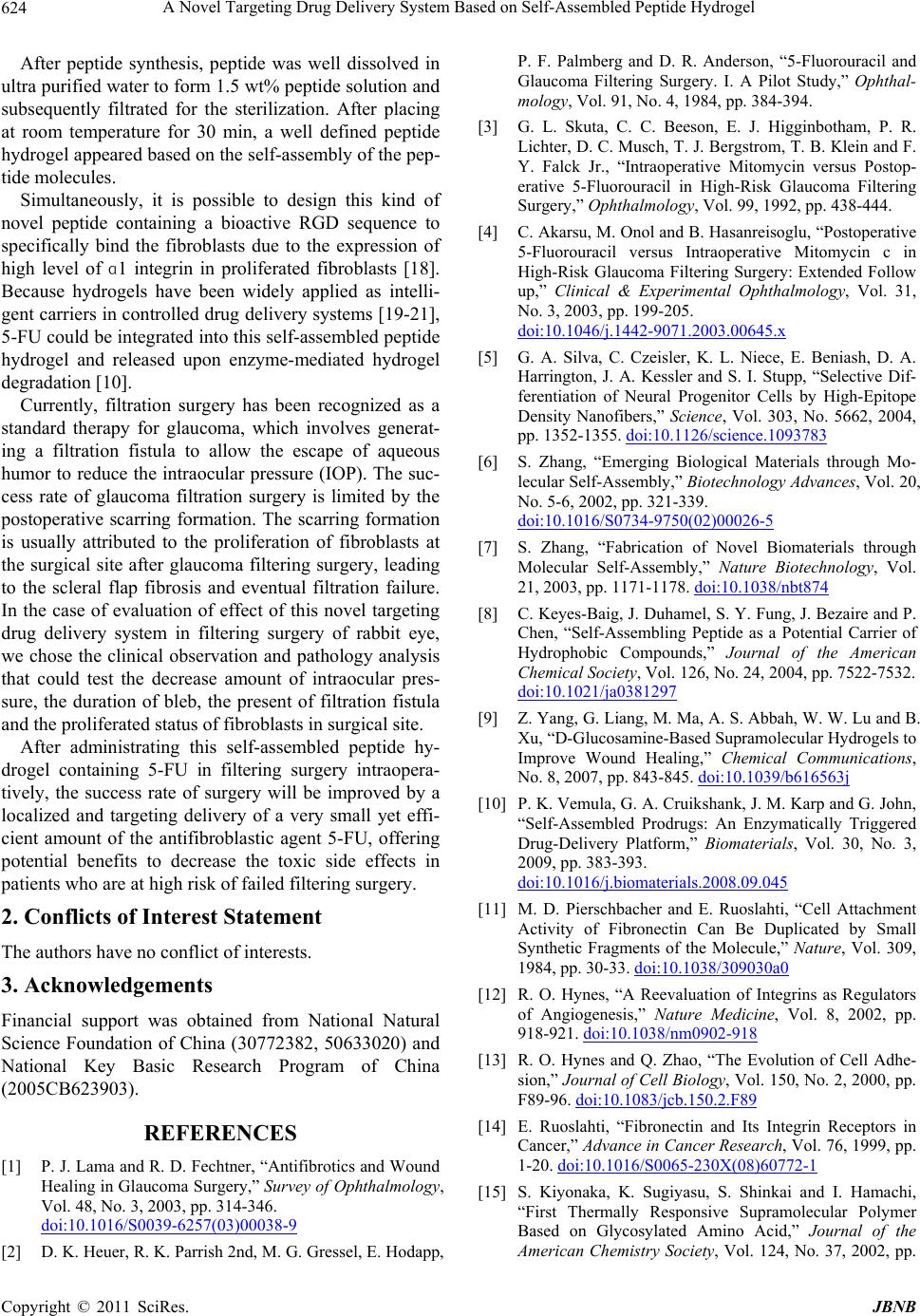
A Novel Targeting Drug Delivery System Based on Self-Assembled Peptide Hydrogel
624
After peptide synthesis, peptide was well dissolved in
ultra purified water to form 1.5 wt% peptide solution and
subsequently filtrated for the sterilization. After placing
at room temperature for 30 min, a well defined peptide
hydrogel appeared based on the self-assembly of the pep-
tide molecules.
Simultaneously, it is possible to design this kind of
novel peptide containing a bioactive RGD sequence to
specifically bind the fibroblasts due to the expression of
high level of 1 integrin in proliferated fibroblastsɑ [18].
Because hydrogels have been widely applied as intelli-
gent carriers in controlled drug delivery systems [19-21],
5-FU could be integrated into this self-assembled peptide
hydrogel and released upon enzyme-mediated hydrogel
degradation [10].
Currently, filtration surgery has been recognized as a
standard therapy for glaucoma, which involves generat-
ing a filtration fistula to allow the escape of aqueous
humor to reduce the intraocular pressure (IOP). The suc-
cess rate of glaucoma filtration surgery is limited by the
postoperative scarring formation. The scarring formation
is usually attributed to the proliferation of fibroblasts at
the surgical site after glaucoma filtering surgery, leading
to the scleral flap fibrosis and eventual filtration failure.
In the case of evaluation of effect of this novel targeting
drug delivery system in filtering surgery of rabbit eye,
we chose the clinical observation and pathology analysis
that could test the decrease amount of intraocular pres-
sure, the duration of bleb, the present of filtration fistula
and the proliferated status of fibroblasts in surgical site.
After administrating this self-assembled peptide hy-
drogel containing 5-FU in filtering surgery intraopera-
tively, the success rate of surgery will be improved by a
localized and targeting delivery of a very small yet effi-
cient amount of the antifibroblastic agent 5-FU, offering
potential benefits to decrease the toxic side effects in
patients who are at high risk of failed filtering surgery.
2. Conflicts of In t e r e st S t a t e m e nt
The authors have no conflict of interests.
3. Acknowledgements
Financial support was obtained from National Natural
Science Foundation of China (30772382, 50633020) and
National Key Basic Research Program of China
(2005CB623903).
REFERENCES
[1] P. J. Lama and R. D. Fechtner, “Antifibrotics and Wound
Healing in Glaucoma Surgery,” Survey of Ophthalmology,
Vol. 48, No. 3, 2003, pp. 314-346.
doi:10.1016/S0039-6257(03)00038-9
[2] D. K. Heuer, R. K. Parrish 2nd, M. G. Gressel, E. Hodapp,
P. F. Palmberg and D. R. Anderson, “5-Fluorouracil and
Glaucoma Filtering Surgery. I. A Pilot Study,” Ophthal-
mology, Vol. 91, No. 4, 1984, pp. 384-394.
[3] G. L. Skuta, C. C. Beeson, E. J. Higginbotham, P. R.
Lichter, D. C. Musch, T. J. Bergstrom, T. B. Klein and F.
Y. Falck Jr., “Intraoperative Mitomycin versus Postop-
erative 5-Fluorouracil in High-Risk Glaucoma Filtering
Surgery,” Ophthalmology, Vol. 99, 1992, pp. 438-444.
[4] C. Akarsu, M. Onol and B. Hasanreisoglu, “Postoperative
5-Fluorouracil versus Intraoperative Mitomycin c in
High-Risk Glaucoma Filtering Surgery: Extended Follow
up,” Clinical & Experimental Ophthalmology, Vol. 31,
No. 3, 2003, pp. 199-205.
doi:10.1046/j.1442-9071.2003.00645.x
[5] G. A. Silva, C. Czeisler, K. L. Niece, E. Beniash, D. A.
Harrington, J. A. Kessler and S. I. Stupp, “Selective Dif-
ferentiation of Neural Progenitor Cells by High-Epitope
Density Nanofibers,” Science, Vol. 303, No. 5662, 2004,
pp. 1352-1355. doi:10.1126/science.1093783
[6] S. Zhang, “Emerging Biological Materials through Mo-
lecular Self-Assembly,” Biotechnology Advances, Vol. 20,
No. 5-6, 2002, pp. 321-339.
doi:10.1016/S0734-9750(02)00026-5
[7] S. Zhang, “Fabrication of Novel Biomaterials through
Molecular Self-Assembly,” Nature Biotechnology, Vol.
21, 2003, pp. 1171-1178. doi:10.1038/nbt874
[8] C. Keyes-Baig, J. Duhamel, S. Y. Fung, J. Bezaire and P.
Chen, “Self-Assembling Peptide as a Potential Carrier of
Hydrophobic Compounds,” Journal of the American
Chemical Society, Vol. 126, No. 24, 2004, pp. 7522-7532.
doi:10.1021/ja0381297
[9] Z. Yang, G. Liang, M. Ma, A. S. Abbah, W. W. Lu and B.
Xu, “D-Glucosamine-Based Supramolecular Hydrogels to
Improve Wound Healing,” Chemical Communications,
No. 8, 2007, pp. 843-845. doi:10.1039/b616563j
[10] P. K. Vemula, G. A. Cruikshank, J. M. Karp and G. John,
“Self-Assembled Prodrugs: An Enzymatically Triggered
Drug-Delivery Platform,” Biomaterials, Vol. 30, No. 3,
2009, pp. 383-393.
doi:10.1016/j.biomaterials.2008.09.045
[11] M. D. Pierschbacher and E. Ruoslahti, “Cell Attachment
Activity of Fibronectin Can Be Duplicated by Small
Synthetic Fragments of the Molecule,” Nature, Vol. 309,
1984, pp. 30-33. doi:10.1038/309030a0
[12] R. O. Hynes, “A Reevaluation of Integrins as Regulators
of Angiogenesis,” Nature Medicine, Vol. 8, 2002, pp.
918-921. doi:10.1038/nm0902-918
[13] R. O. Hynes and Q. Zhao, “The Evolution of Cell Adhe-
sion,” Journal of Cell Biology, Vol. 150, No. 2, 2000, pp.
F89-96. doi:10.1083/jcb.150.2.F89
[14] E. Ruoslahti, “Fibronectin and Its Integrin Receptors in
Cancer,” Advance in Cancer Research, Vol. 76, 1999, pp.
1-20. doi:10.1016/S0065-230X(08)60772-1
[15] S. Kiyonaka, K. Sugiyasu, S. Shinkai and I. Hamachi,
“First Thermally Responsive Supramolecular Polymer
Based on Glycosylated Amino Acid,” Journal of the
American Chemistry Society, Vol. 124, No. 37, 2002, pp.
Copyright © 2011 SciRes. JBNB